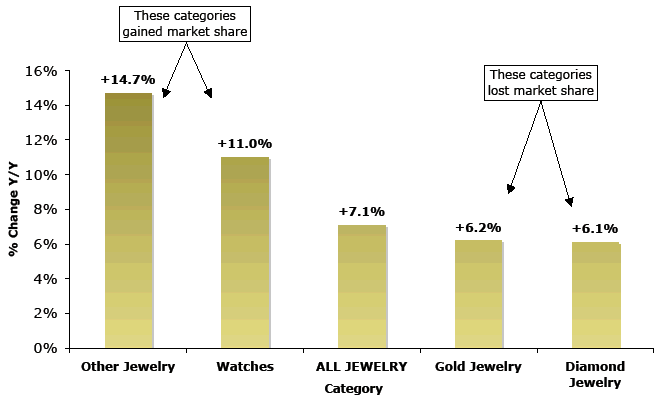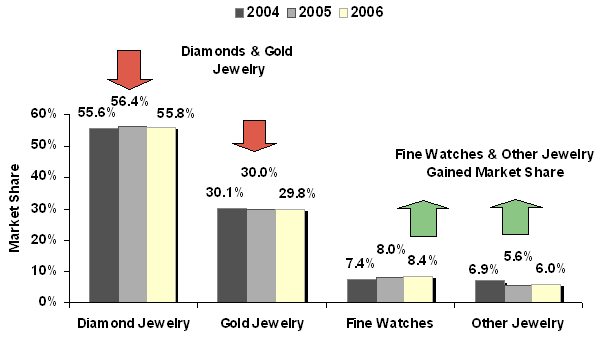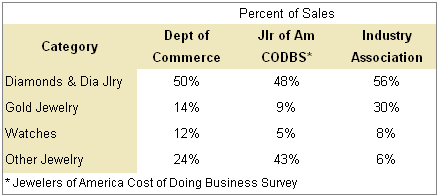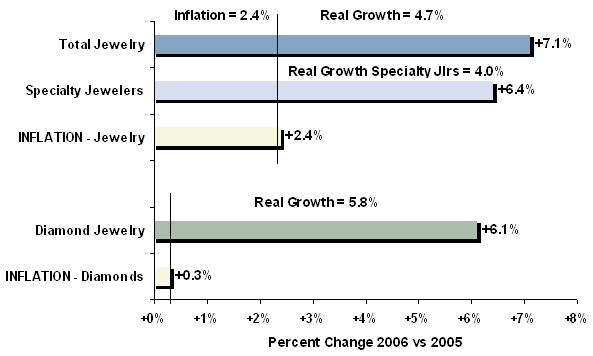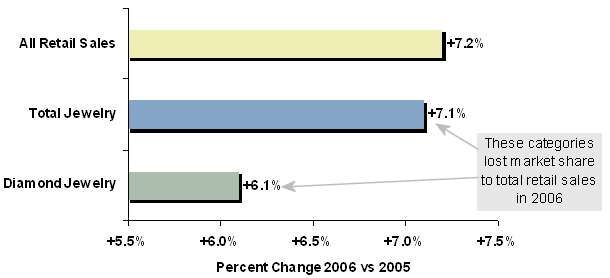IDEX Online Research: Watches & “Other” Jewelry Gain Market Share, Gold & Diamonds Lose
April 17, 07
In 2006, jewelry sales in the U.S. rose by a robust 7.1 percent, the largest gain since 1999. Despite this strong performance, jewelry lost share of wallet among American shoppers, whose spending on retail goods rose by 7.2 percent.
Two key jewelry categories were responsible for most of the loss of jewelers’ market share: diamond jewelry and gold jewelry. These two categories account for roughly 60 percent or more of all jewelry sold in America, according to figures from Jewelers of America.
The only readily identifiable jewelry category to gain market share in 2006 was the fine watch category, which represents about 8 percent of all jewelry sold in the U.S. All other jewelry, consisting of colored gemstone jewelry, pearls, precious metal jewelry such as silver and platinum, and all other categories, also gained market share, though it is not absolutely clear which categories fueled the gain.
Circumstantial research suggests that colored gemstone jewelry and silver jewelry were particularly strong, but there are no reliable figures to prove, or disprove, this assumption.
The graph below illustrates which jewelry categories gained market share in 2006 and which lost market share.
| U.S. Market - 2006 Sales Growth Trends |
The following graph illustrates the shifts in market share trends by jewelry category for the past three years. The red arrow (market share down) and green arrow (market share up) refer to market share changes in 2006 versus 2005. It is notable that these shifts were only very modest; none-the-less, they are statistically significant. These market share statistics are based on figures provided by various industry associations such as the Diamond Information Center (DIC), the World Gold Council (WGC), and LGI Network. They were not derived from an independent sample of jewelers.
| U.S. Market - Three-Year Market Share Trend |
Diamond Jewelry Loses Market Share
Diamond jewelry generates just under 56 percent of total U.S. jewelry sales, according to figures provided by the DIC. Diamond jewelry gained market share in each year in the eleven-year period since 1995, but lost a modest amount of market share in 2006.
A full analysis of diamond jewelry sales in 2006 (IDEX Online Research: Diamond Jewelry Loses Market Share in 2006) can be found here.
Gold Jewelry Loses Market Share
Based on preliminary results, gold jewelry sales grew by only 6.2 percent in 2006, a rate also below total jewelry industry growth. Thus, gold jewelry lost market share, despite a sharp rise in gold prices during the year. Total tons of gold used in jewelry manufacturing in the U.S. market fell by 12 percent in 2006, according to the WGC, but total sales rose by 6.2 percent due to inflationary pricing of gold jewelry, based on preliminary data.
The WGC will publish detailed information on gold jewelry sales by channel of distribution and product sub-category later this spring.
Watch Category Gains Market Share
Fine watch sales represented about 8 percent of total U.S. jewelry sales in 2006, according to LGI Network. Fine watch sales were about $5.3 billion, up about 11 percent from 2005’s $4.7 billion. This large gain was well above the total sales increase for all jewelry of +7.1 percent, and indicates that fine watches took significant market share from other jewelry categories. Most jewelers in the IDEX Online research sample also reported strong watch sales in 2006. In addition, Movado reported that its 2006 sales were up 13.2 percent, a very strong gain.
Other Jewelry Gains Market Share
Data on “other jewelry” categories is sparse. While statistics are available on the commodity value of precious metals used for jewelry in the U.S. market, there are no reliable statistics about the retail value – via retail sales at retail prices – of these categories.
According to the Jewelers of America Cost of Doing Business Survey, the following categories are included in jewelry other than gold jewelry, diamond jewelry, and fine watches.
- Colored stone jewelry
- Fashion jewelry
- Pearls
- Platinum jewelry
- Estate/antiques
- Flatware
- Appraisals, repairs
- All other
An informal poll of specialty jewelers indicates that colored gemstone sales have been particularly strong. In addition, silver jewelry demand has also been robust. However, neither category carries an average ticket nearly as large as diamond or gold jewelry. Thus, for these categories to have a significant impact on overall industry revenues, it is clear that they enjoyed a particularly high velocity and large volume of sales.
Further, Jewelers of America data indicates that colored gemstone jewelry and watches were high growth categories in 2005, a trend which we believe continued through 2006.
Which Numbers Have Integrity?
There are some significant disparities between sales numbers which the various jewelry industry associations report and the numbers which specialty jewelers report.
The table below illustrates the percent of total industry sales reported by U.S. independent specialty jewelers as summarized by the U.S. Department of Commerce, the Jewelers of America Cost of Doing Business Survey, and sales as reported by the various industry associations.
| U.S. Jewelers Sales by Category |
Obviously, it is in the best interest of the industry associations to put the best possible spin on their annual sales results, so it is no surprise that some of the numbers appear to be significantly inflated. However, we believe that some of the differences also relate to definitions. The explanations below tend to shed some light on these disparities.
Diamond Jewelry
Based on recent statistics published by the DIC, diamond jewelry sales of $35.2 billion represented just under 56 percent of a jeweler’s revenues in 2006. There is enough corroborating data to confirm that this number is not unreasonable, even if it is an estimate. However, research by Tacy, an independent research firm which is affiliated with IDEX Online, indicates that U.S. diamond jewelry sales were about $34 billion in 2006, or just under 54 percent of a jeweler’s total sales. In addition, earlier research by other independent firms also indicate that sales figures from the DIC may be at the high end of the reasonable range. In addition, due to a change this year in the DIC’s sampling method, the likely statistical error bias would be on the high side.
Gold Jewelry
The WGC says that U.S. gold jewelry sales in 2006 were about $18.8 billion. The WGC says this number consists of the total retail value of jewelry in which gold is at least 50 percent of the commodity value; that’s the same definition which the U.S. Department of Commerce uses (see table above).
Based on WGC numbers, gold jewelry represents just under 30 percent of all jewelry sold. Unfortunately, IDEX Online Research does not have data to corroborate this number. Most industry statistics suggest that it is much lower. For example, jewelers responding to the Jewelers of America Cost of Doing Business Survey say that their gold jewelry sales are 9 percent of total sales, while the Department of Commerce says gold jewelry sales constitute about 14 percent of a jeweler’s total sales.
However, we believe that the WGC has sound research methodology, and much of the disparity probably lies in the definitions that survey respondents use. Further, WGC numbers reflect a much larger universe of retailers selling gold jewelry, including specialty jewelers, department stores, discounters, mass marketers, mail order, and other categories. However, even if we adjust for this large universe, the WGC numbers are still much higher than those reported by specialty jewelers, including independents and chains.
Watches
Watch numbers come from LGI Network. Because they are an independent research organization, “they don’t have a dog in this fight,” as the old adage goes. Thus, we believe that their numbers are highly reliable. According to the U.S. Department of Commerce, total watch sales are about 13 percent of total U.S. jewelry sales, though Jewelers of America survey respondents say their watch sales are about 5 percent of total store sales. LGI’s figures indicate that fine watch sales are just over 8 percent of total U.S. jewelry sales. LGI defines “fine watch sales” as sales of watches with a MSRP of $50 or greater sold through independent jewelry stores in the 48 contiguous states. While it is clear that this sample excludes some key watch distribution, it captures trends with a high degree of reliability, in our opinion.
Inflation Helped Drive Jewelry Sales
During nine of the past eleven years, retail prices of jewelry have fallen in America. However, in 2006 (as well as 2004), retail prices of jewelry rose. The increase in prices in 2006 was significant: +2.4 percent. Thus, real or “unit” growth of jewelry rose by approximately 4.7 percent, as the graph below illustrates.
| U.S. Market - Spending Trends & Inflation 2006 |
Further, as the graph illustrates, diamond price inflation, as measured by the IDEX Online Polished Price Index, rose by a very modest 0.3 percent in 2006. Thus, real or “unit” growth of the diamond category exceeded the real growth rate of the total jewelry category.
This kind of analysis helps understand the difference between “sales” growth and “piece growth” of a category. In its recent press release, the DIC noted that the average ticket for diamond jewelry rose by 9.1 percent, but total transactions declined by 2.7 percent. This suggests that unit growth was just over 6 percent, which is close to the IDEX Online projection of 5.8 percent unit growth for diamonds, based on adjusting for inflation.
These are two different research methodologies which are trying to get an answer to the same question: what was the gain in unit sales of diamonds in 2006? The answer: about +6 percent.
Jewelry Lost Market Share to Other Retail Categories
Unfortunately, the U.S. jewelry industry – diamonds, all jewelry, and all luxury goods – lost market share to total U.S. retail sales (ex-autos and food). Total U.S. retail sales (ex-autos and food) rose by 7.2 percent in 2006, according to the U.S. Department of Commerce. Total jewelry industry sales were up by 7.1 percent and diamond sales were up by 6.1 percent.
The graph below illustrates the growth of all jewelry and diamond jewelry to all U.S. retail sales.
| U.S. Market - Spending Trends 2006 |
